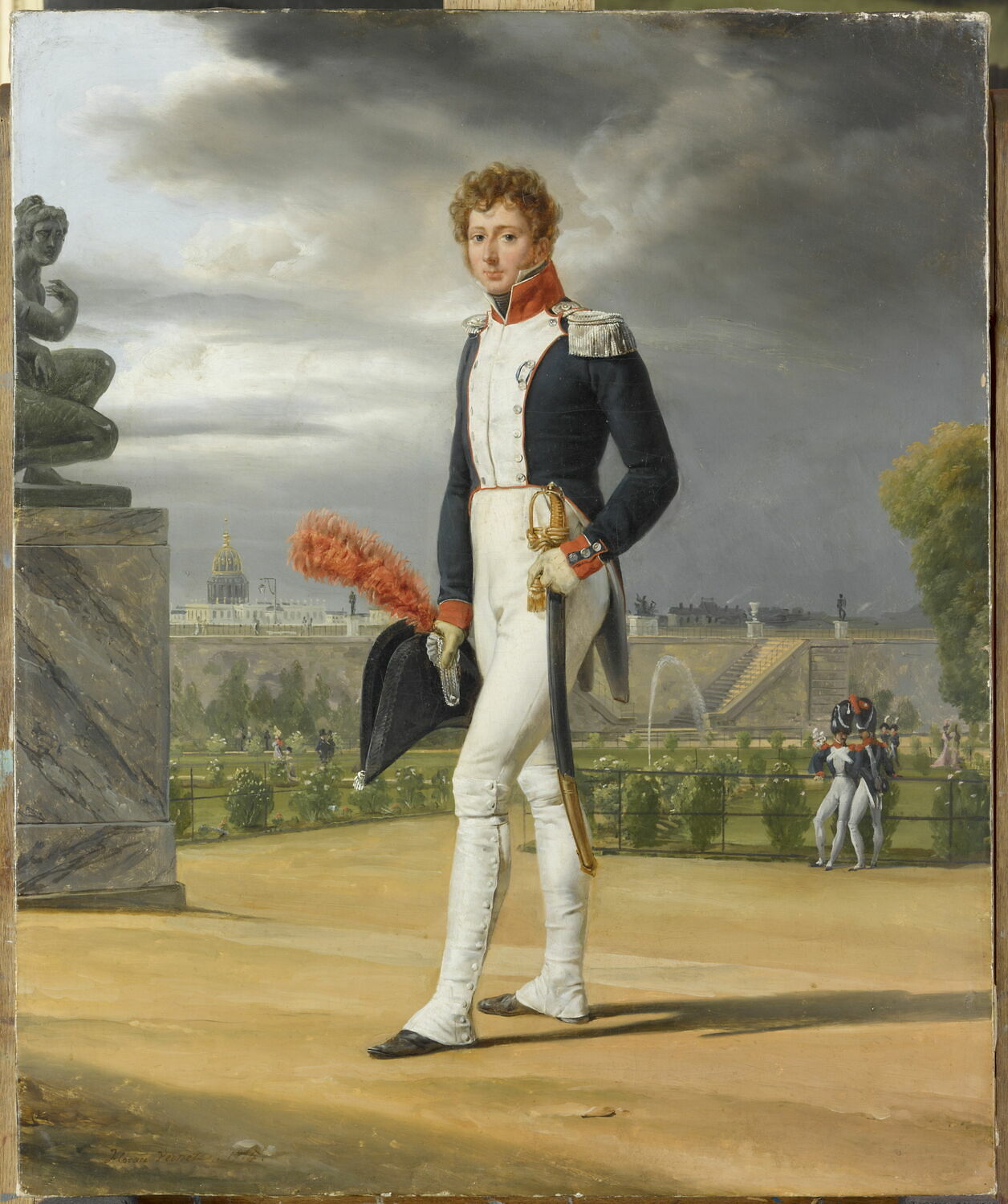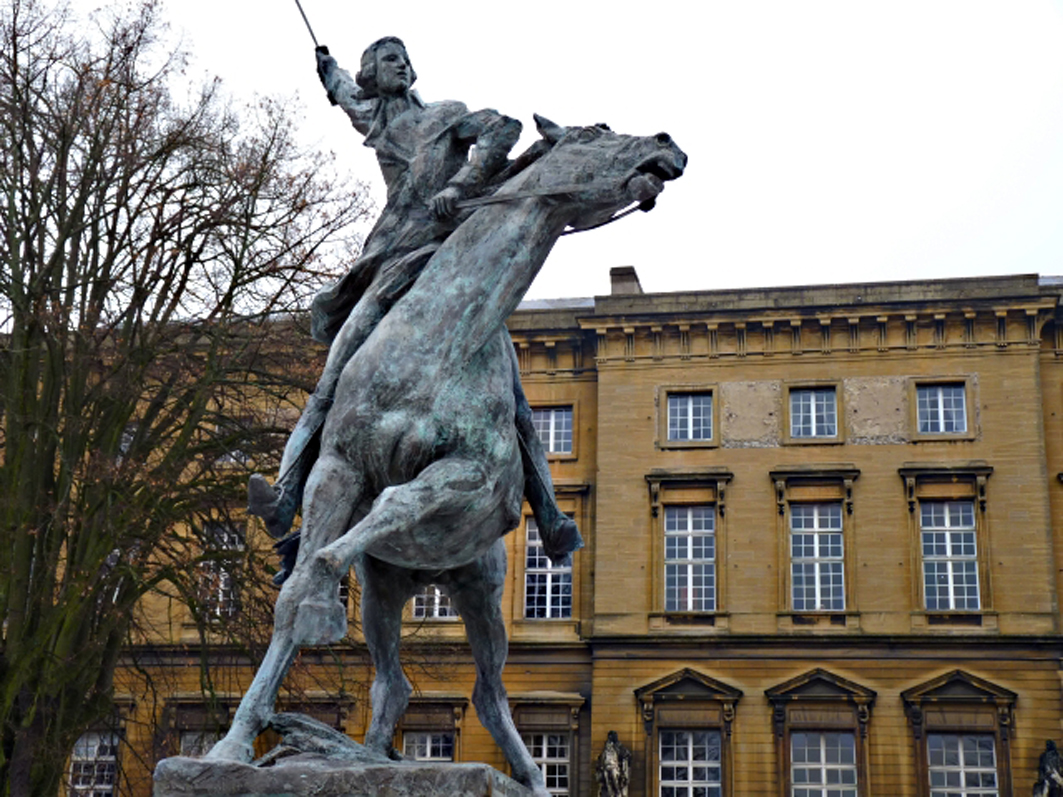|
Jean-Baptiste Drouet (revolutionary)
Jean-Baptiste Drouet (8 January 1763 – 11 April 1824) was a French politician of the Revolution and the Empire, best known for his key role in the arrest of King Louis XVI and his family during the Flight to Varennes. Background Drouet was born at Sainte-Menehould, in the province of Champagne. He enlisted in the Condé-Dragons regiment in 1781, but left seven years later to help his father in his duties as postmaster of Sainte-Menehould. Flight to Varennes On 21 June 1791, at around 8.p.m, the berline carrying the disguised royal family on their flight to the frontier made a stop at Sainte-Menehould. About 13 hours earlier, a valet de chambre in the Tuileries had noticed the king's disappearance and alerted the authorities. Shortly after the royal family's arrival, Drouet (by then himself the city's postmaster) recognized the king, under the identity of a valet "Mr. Durand", from his portrait printed on an assignat in his possession, but did not take action immediately. ... [...More Info...] [...Related Items...] OR: [Wikipedia] [Google] [Baidu] |
Sainte-Menehould
Sainte-Menehould (; ) is a Communes of France, commune in the Marne (department), Marne Departments of France, department in north-eastern France. The 18th-century French playwright Charles-Georges Fenouillot de Falbaire de Quingey (1727–1800) died in Sainte-Ménéhould. It was the Subprefectures in France, subprefecture of the arrondissement of Sainte-Menehould until its abolition in April 2017.Décret n° 2017-453 du 29 mars 2017 portant suppression de l'arrondissement de Sainte-Menehould (département de la Marne) History Dom Pérignon (monk), Dom Pérignon, the Order of St. Benedict, Benedictine monk who made important contributions to the production and quality of Champag ...[...More Info...] [...Related Items...] OR: [Wikipedia] [Google] [Baidu] |
Berlin (carriage)
A Berlin or Berline carriage is a type of enclosed four-wheeled carriage with two interior bench seats facing one-another. Initially noted for using two perch rails and having the body suspended by leather straps called braces, the term continued in use for many carriages even after the suspension system changed to steel springs. History The carriage was designed around 1660 or 1670 by a Piedmontese architect commissioned by the General quartermaster to Frederick William, Elector of Brandenburg who used the carriage to travel 1,054 km (654.9 mi) from Berlin to Paris, where his carriage created a sensation. While some heavy-duty vehicles had used double-perches before, passenger vehicles had normally used a single perch. The elegant but durable style was widely copied and named "berline" after the city from which the carriage had come. It was more convenient than other carriages of the time, being lighter and less likely to overturn. The berline began to supplant the less p ... [...More Info...] [...Related Items...] OR: [Wikipedia] [Google] [Baidu] |
Versailles, Yvelines
Versailles ( , ) is a commune in the department of the Yvelines, Île-de-France, known worldwide for the Château de Versailles and the gardens of Versailles, which is designated an UNESCO World Heritage Sites. Located in the western suburbs of the French capital, from the centre of Paris, Versailles is a wealthy suburb of Paris with a service-based economy and is a major tourist destination. According to the 2017 census, the population of the city is 85,862, down from a peak of 94,145 in 1975.Population en historique depuis 1968 , INSEE A founded by order of King |
Étienne Radet
Étienne, baron Radet (; 1762 – 27 September 1825) was a French Army officer who served in the French Revolutionary and Napoleonic Wars. He is best known for arresting Pius VII on 6 July 1809. Biography Radet was born at Stenay, in 1762. He joined the Régiment de La Sarre as a soldier on 4 April 1780. He was promoted to corporal on 20 March 1781, and sergeant on 26 April 1782. Dismissed on 12 October 1786, he became a constabulary's rider on 30 November. He was appointed as a general of brigade in 1800 by Napoleon Bonaparte, who gave him the chief command of all the Gendarmerie (armed police.) In 1809, he was ordered to Rome. In July of that year he arrested the Pope Pius VII in his palace and conducted him to Florence. He received the title of baron (1809), and became a general of division in 1813. In June 1815, he was appointed Grand Provost of the Gendarmerie (i.e. military police) accompanying the French army in Belgium during the Waterloo Campaign. He was present ... [...More Info...] [...Related Items...] OR: [Wikipedia] [Google] [Baidu] |
National Guard (France)
The National Guard () is a French military, gendarmerie, and police reserve force, active in its current form since 2016 but originally founded in 1789 during the French Revolution. It was founded as separate from the French Army and existed both for policing and as a military reserve. However, in its original stages from 1792 to 1795, the National Guard was perceived as revolutionary and the lower ranks were identified with sans-culottes. It experienced a period of official dissolution from 1827 to 1830 but was reestablished. Soon after the Franco-Prussian War of 1870–71, the National Guard in Paris again became viewed as dangerously revolutionary, which contributed to its dissolution in 1871. In 2016, France announced the reestablishment of the National Guard for the second time, in response to a series of terrorist attacks in the country. Creation The raising of a "Bourgeois Guard" (''"garde bourgeoise"'') for Paris was discussed by the National Assembly on 11 Jul ... [...More Info...] [...Related Items...] OR: [Wikipedia] [Google] [Baidu] |
Aire (Aisne)
The Aire () is a river of northern France, crossing the departments of Meuse and Ardennes. It is a right tributary of the Aisne. It is long. Its source is near Saint-Aubin-sur-Aire in Meuse. It flows through the towns of Pierrefitte-sur-Aire, Clermont-en-Argonne, Varennes-en-Argonne Varennes-en-Argonne (, literally ''Varennes in Argonne'') or simply Varennes (German: Wöringen) is a commune in the Meuse department in the Grand Est region in Northeastern France. In 2019, it had a population of 639. Geography Varennes-en-A ... and Grandpré, finally flowing into the Aisne in Termes. References Rivers of France Rivers of Grand Est Rivers of Meuse (department) Rivers of Ardennes (department) {{France-river-stub ... [...More Info...] [...Related Items...] OR: [Wikipedia] [Google] [Baidu] |
Les Islettes
Les Islettes () is a commune in the Meuse department of Grand Est in north-eastern France. See also *Communes of the Meuse department The following is a list of the 499 Communes of France, communes of the Meuse (department), Meuse Departments of France, department of France. The communes cooperate in the following Communes of France#Intercommunality, intercommunalities (as of ... References Islettes {{Meuse-geo-stub ... [...More Info...] [...Related Items...] OR: [Wikipedia] [Google] [Baidu] |
Forest Of Argonne
The Forest of Argonne () is a long strip of mountainous and wild woodland in northeastern France, approximately east of Paris. The forest measures roughly long and wide filled with many small hills and deep valleys formed by water run-off from the Aire River (France), Aire and Aisne (river), Aisne rivers rarely exceeding more than in elevation. Following the First World War, the landscape of the forest was forever changed as trench warfare led to parts of the forest being riddled with deep human-made trenches along with craters from explosives. The forest is bordered by the Meuse River on the west and rolling farmland and creeks to the east. The forest is largely oak, chestnut, and pine trees, and ferns cover much of the forest floor. Common animal life consists of wild boar, red deer, roe deer, hares, rabbits, foxes, and wildcat. History In 1792, Charles François Dumouriez outmaneuvered the invading forces of the Charles William Ferdinand, Duke of Brunswick, Duke of Bru ... [...More Info...] [...Related Items...] OR: [Wikipedia] [Google] [Baidu] |
Clermont-en-Argonne
Clermont-en-Argonne (, literally ''Clermont in Argonne''; formerly Clermont-sur-Meuse, literally ''Clermont on Meuse'') is a commune in the Meuse department in Grand Est in north-eastern France. The former towns of Auzéville-en-Argonne, Jubécourt, and Parois were joined to Clermont-en-Argonne in 1973. Geography The town is located along the old road from Paris to Verdun ( RN3), which at this point is closely tracked by the A4 autoroute, on the edge of the Forest of Argonne. It is approximately 15 km to the east of Sainte-Menehould. Clermont's population has declined slightly in the last decades to 1,449 (in 2020), which gives a population density of 22 inhabitants per km2. The mechanisation of agriculture that took place during the 20th century left this region, which remains overwhelmingly rural, short of employment opportunities: Clermont's economy has tended to suffer from the drift of working age populations to the towns and cities. Population History During ... [...More Info...] [...Related Items...] OR: [Wikipedia] [Google] [Baidu] |
Varennes-en-Argonne
Varennes-en-Argonne (, literally ''Varennes in Argonne'') or simply Varennes (German: Wöringen) is a commune in the Meuse department in the Grand Est region in Northeastern France. In 2019, it had a population of 639. Geography Varennes-en-Argonne lies on the river Aire to the northeast of Sainte-Menehould, near Verdun. History Varennes is most notable as it was the ending point of the Flight to Varennes. In June 1791, Louis XVI and his immediate family made a dash for the nearest friendly border, that of the Austrian Netherlands in modern Belgium (Queen Marie Antoinette being a sister to Leopold II, Archduke of Austria and Holy Roman Emperor). In Varennes, Louis and his family were arrested by Jean-Baptiste Drouet, the local postmaster, who had been alerted by a message received from nearby Sainte-Menehould. It is said that at Sainte-Menehould, where the escaping party had spent the previous night, a merchant alerted the town authorities of their presence after recogn ... [...More Info...] [...Related Items...] OR: [Wikipedia] [Google] [Baidu] |
Gilbert Du Motier, Marquis De Lafayette
Marie-Joseph Paul Yves Roch Gilbert du Motier de La Fayette, Marquis de La Fayette (; 6 September 1757 – 20 May 1834), known in the United States as Lafayette (), was a French military officer and politician who volunteered to join the Continental Army, led by General George Washington, in the American Revolutionary War. Lafayette was ultimately permitted to command Continental Army troops in the decisive Siege of Yorktown in 1781, the Revolutionary War's final major battle, which secured American independence. After returning to France, Lafayette became a key figure in the French Revolution of 1789 and the July Revolution of 1830 and continues to be celebrated as a hero in both France and the United States. Lafayette was born into a wealthy land-owning family in Chavaniac in the province of Auvergne in south-central France. He followed the family's martial tradition and was commissioned an officer at age 13. He became convinced that the American revolutionary cause was ... [...More Info...] [...Related Items...] OR: [Wikipedia] [Google] [Baidu] |
Assignat
An assignat () was a monetary instrument, an order to pay, used during the time of the French Revolution, and the French Revolutionary Wars. France Assignats were paper money (fiat currency) authorized by the Constituent Assembly in France from 1789 to 1796, during the French Revolution, to address imminent bankruptcy. They were originally backed by the value of properties now held by the nation; those of the crown taken over on 7 October, and those of the Catholic Church, which were confiscated, on the motion of Mirabeau, by the Assembly on 2 November 1789. Credit was wrecked, according to Talleyrand; for Mirabeau "the deficit was the treasure of the nation". In September the treasury was empty. Charles Maurice de Talleyrand-Périgord proposed "national goods" should be given back to the nation. Necker proposed to borrow from the Caisse d'Escompte, but his intention to change the private bank into a national bank similar to the Bank of England failed. A general default ... [...More Info...] [...Related Items...] OR: [Wikipedia] [Google] [Baidu] |




